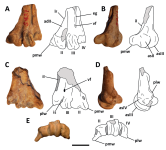Fred Ruhe
Well-known member

Federico L. Agnolín (2023)
A new species of the Falcon genus Thegornis (Aves) from the Miocene of Northwestern Argentina.
Historia Natural (tercera serie) 13 (2): 15-24.
Free pdf: https://fundacionazara.org.ar/img/revista-historia-natural/tercera-serie-volumen-13-2-2023/HN_13_2_15-24.pdf
Abstract.
The aim of the present contribution is to describe a new species of the extinct falcon genus Thegornis. The species is based on the distal end of a tarsometatarsus coming from late Miocene beds of Catamarca province, Argentina. The new taxon is distinguished from closely related forms by details in tarsometatarsus trochleae. It constitutes the second bird genus from Miocene Catamarca province that is shared with fossil bird assemblages of early-middle Miocene of Santa Cruz province, Argentina.
Enjoy,
Fred
A new species of the Falcon genus Thegornis (Aves) from the Miocene of Northwestern Argentina.
Historia Natural (tercera serie) 13 (2): 15-24.
Free pdf: https://fundacionazara.org.ar/img/revista-historia-natural/tercera-serie-volumen-13-2-2023/HN_13_2_15-24.pdf
Abstract.
The aim of the present contribution is to describe a new species of the extinct falcon genus Thegornis. The species is based on the distal end of a tarsometatarsus coming from late Miocene beds of Catamarca province, Argentina. The new taxon is distinguished from closely related forms by details in tarsometatarsus trochleae. It constitutes the second bird genus from Miocene Catamarca province that is shared with fossil bird assemblages of early-middle Miocene of Santa Cruz province, Argentina.
Enjoy,
Fred
Last edited:




